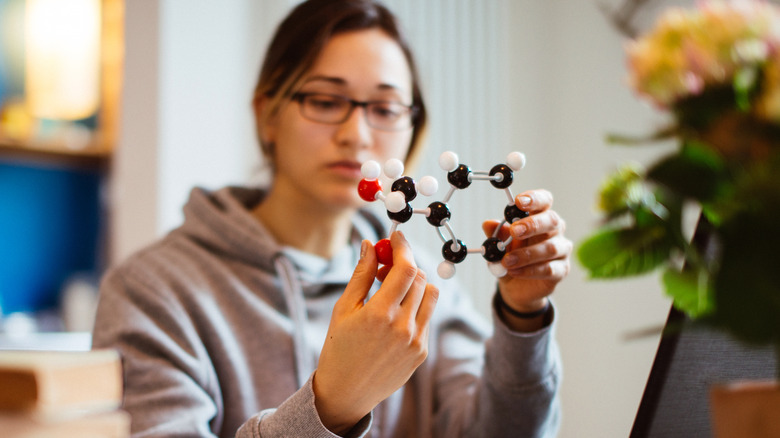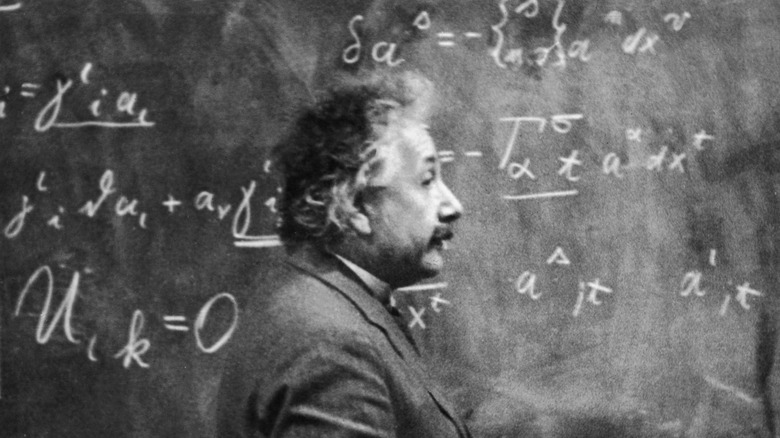Why Matter Can't Be Created Or Destroyed: The Law Of Conservation Of Mass Explained
One truly elegant hypothesis of physics is the "zero-energy universe" hypothesis. It proposes that the net sum of the energy in the universe perfectly equates to zero. According to the idea, if you were to add up the energy and mass of every planet, star, water molecule, graviton, hummingbird, and everything else, it would all equal zero. In other words, the model suggests that the positive energy and the negative energy in the universe is perfectly balanced. Though it's basically impossible to calculate, since doing so would require measuring the mass–energy of the entire universe, the zero-energy universe hypothesis seems reasonable considering a well-established law of physics.
The law of conservation of mass states that mass can neither be created nor destroyed. Interestingly, numerous ancient philosophers observed the knack for chemical and physical reactions to simply rearrange matter rather than delete it from existence. For instance, a piece of wood can't be burned without producing a substantial amount of smoke and a small pile of carbon ash. Even non-scientists could see that matter never really disappears.
Although such early observations were on the right track, they weren't based in objective science. It wasn't until the modern age that scientists provided empirical evidence for the phenomenon. In 1789, Antoine Lavoisier discovered how mass can't be created or destroyed. He published scientific proof that in any closed chemical reaction, the number of atoms, and therefore the mass of the system, remained the same from beginning to end. Years later, the conservation of mass hypothesis was further refined. It was proposed that mass and energy were essentially the same in different forms. Thus, the concept of mass–energy, in one combined term, explained how nuclear reactions could lose mass and still retain the balance of the system.
When the conservation of mass holds true — and when it doesn't
The law of the conservation of mass holds true for both physical and chemical reactions. In a physical reaction, the atoms and molecules in the system retain the same composition, even while combining together in new ways. For example, liquid water freezing into solid ice is a physical reaction, yet the change in temperature doesn't actually change the chemical composition of the system. Intuitively, a gram of liquid water and a gram of ice contain the same amount of atoms, so the law is retained.
In a chemical reaction, the molecules and atoms change their configurations to form new chemical structures. Such reactions occur from some form of catalyst, such as a change in temperature or the introduction of a reactive chemical. Consequently, the conservation of mass in a chemical reaction isn't as apparent as that of a physical reaction, yet it still abides by the conservation of mass. Components of a chemical reaction may turn into gases, explode in fantastic flashes of light, burn into charred stains, or reduce into much smaller volumes. Nonetheless, the total amount of atoms involved in the reaction remains the same, which means that the total mass of the system also remains the same. Simply put, the combination of elements into new molecules will release or absorb energy, but the atoms involved remain the same.
In a beautiful outcome of physics and chemistry, we now know that basically every atom on Earth was created billions of years ago from the high-energy explosions of supernovas and within the hearts of the universe's earliest stars. However, such a revelation leads to another question: Is the law of the conservation of mass maintained when the nuclear structure of atoms is fundamentally changed?
How Einstein saved the conservation of mass
On the surface, nuclear reactions seem to break the rule of the conservation of mass. However, Einstein's theories of relativity provide a solution. In fact, it's Einstein's most famous equation that both threatened and solved the conundrum: E=mc2. Basically, by considering mass and energy to be two forms of the same thing, a new perspective was born. That famous equation proves that while a system's mass might change via a nuclear reaction, the overall mass–energy of the system remains the same.
In a nuclear reaction, whether via fission or fusion, the distinction between mass and energy is hazy. Unlike a physical or chemical reaction, the atoms involved in a nuclear reaction may change their atomic values. In a neat turn of mathematics, the energy released and the mass lost in the process are directly correlated from beginning to end.
Because mass is a property of matter, the "stuff" of the universe affected by gravity, nuclear reactions still conserve the overall mass–energy of systems. Indeed, only in nuclear physics, developed in the early 20th century, does the conservation of mass seem to falter. On Earth, few commonplace events create the conditions required to cause a "mass defect," or conversion of mass into energy. Mass defects occur in nuclear reactions, such as stellar fusion and the fission in atomic bombs.
With the law of the conservation of mass in jeopardy, one of the first experiments to save the phenomenon (and confirm Einstein's theories) was performed in 1932 by Cockroft and Walton, who accelerated particles to observe high-energy reactions of atoms in which their atomic values changed. The experiment concluded that when mass was lost, an equivalent amount of energy was released. The study was the first of many to support the equivalency between mass and energy.
The current state of the law of conservation of mass
The law of conservation of mass might depend on Einsteinian physics when nuclear reactions come into play, but less lofty, more common examples occur in our everyday lives with chemical and physical reactions. Mass, energy, and weight in the real world are much easier to visualize and observe, and the distinction between mass and energy becomes less perceptible.
One classic example is the burning of wood. Whether it's in a bonfire or a safety match, wood burns to create ashes, carbon dioxide, and water vapor. Combustion depends on the oxygen gas present in the air, which fuels the reaction. In fact, the introduction of oxygen particles with heat and the carbon present in the wood is what combines to form the wonderful flame that we all know. What some folks may not know, however, is that combustion starts and ends with the same amount of mass. In fact, all of the elements in the beginning of a combustion reaction are still present at its end. Though they change molecular structure and that change emits heat, the elements involved in burning wood are all present once the wood has converted into smoke and ashes.
Perhaps the most important example of the conservation of mass for us humans occurs in photosynthesis. Plants convert carbon dioxide into carbohydrates, releasing the oxygen (the "dioxide" part of "carbon dioxide"). When those plants get eaten, their carbohydrates are converted back into carbon gasses, including methane and carbon dioxide. Throughout the entire cycle, no matter nor mass is lost. Energy of the system may be lost as heat, but plants use energy from the sun to catalyze the process of photosynthesis in the first place. Thus, both mass and energy are conserved.



